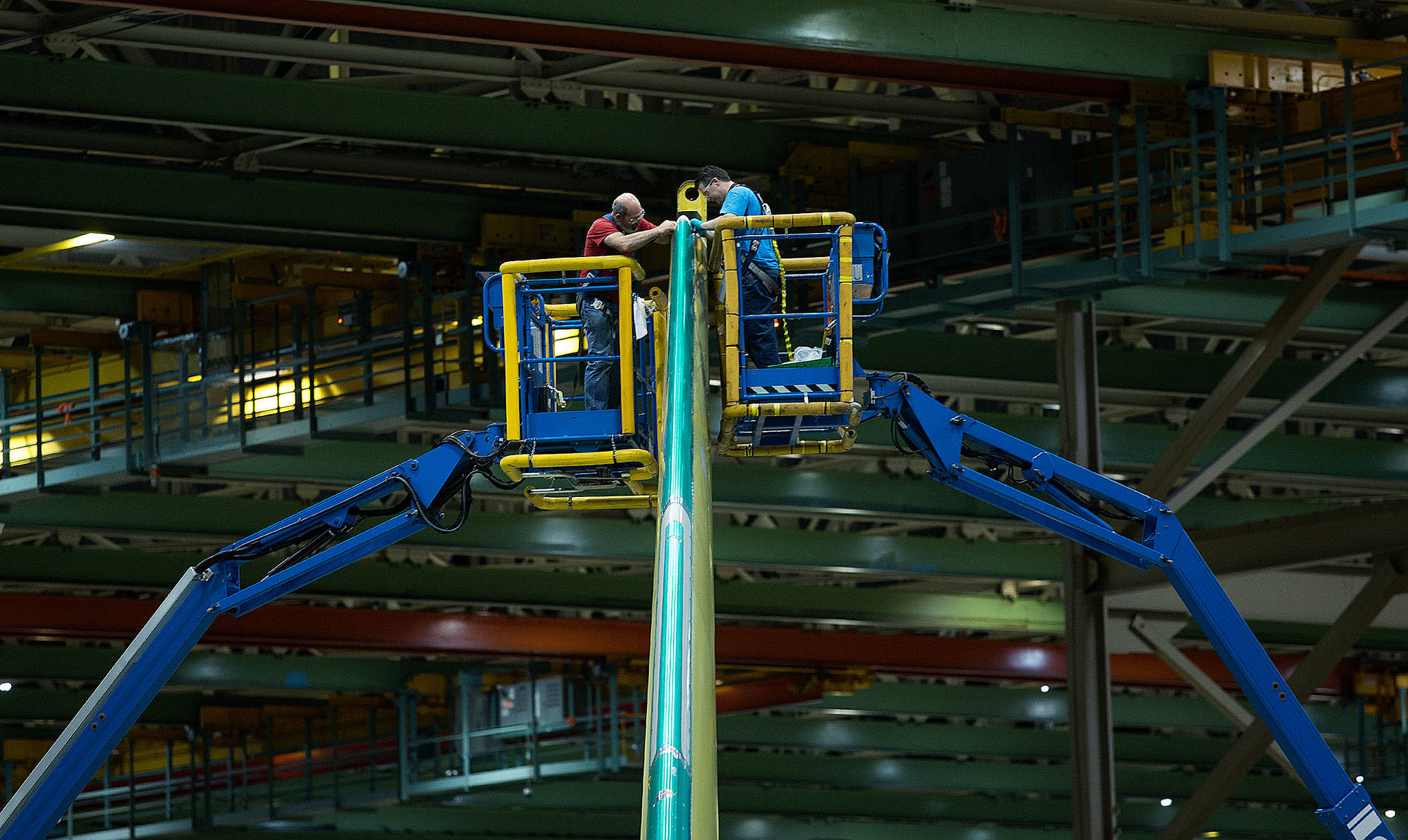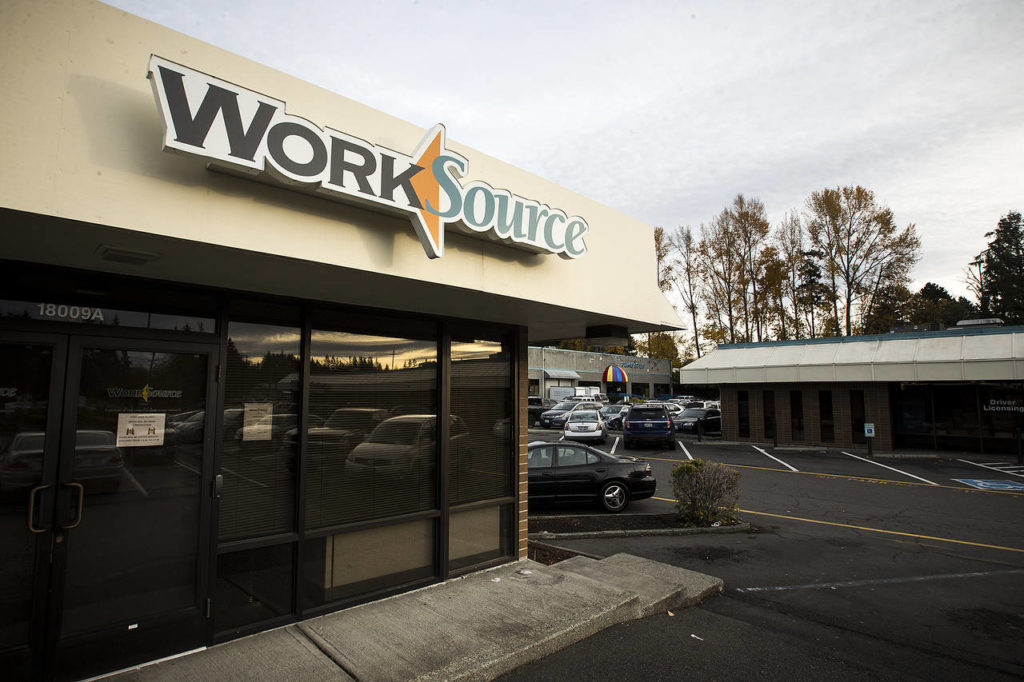LYNNWOOD — Their long, fruitful careers at the Boeing Co. came to an abrupt end this year.
Gary Stone and Larry Lupescu are now helping other unemployed aerospace workers find new professional lives. There’s plenty to do on that front, given the thousands of local Boeing jobs that have moved away or disappeared during the past year.
From an office in Lynnwood, they greet other refugees from the area’s biggest employer, its suppliers or other occupations that felt the ripple effect. They loved working for Boeing, while it lasted. They also realize, better than most, that their peers may need to adjust to a changing landscape.
“We understand Boeing culture. We have been in the middle of it — and then boom!” said Stone, 54, an engineer who had worked half his life with the company when he was laid off this spring. “I not only lost my job, I lost my career. I lost part of my identity. It completely turns your world upside down.”
Many others can empathize.
As of October, Boeing employed 66,242 workers in Washington. While that’s a huge number, it’s nearly 10 percent less than the 73,372 who worked for the company statewide a year earlier, according to online employment figures from the company.
In some ways, that’s nothing new. The jet-building business is cyclical. The workforce ebbs and flows.
Boeing has signaled it’s preparing to add jobs soon, with the potential for still more in the near future.
‘In the same boat’
In Lynnwood, the Re-Employment Center run by the nonprofit Workforce Snohomish provides the only one-stop shop of its kind for recently laid-off Boeing workers. It teams up federal, state and nonprofit resources, with an emphasis on training. Its office sits across the parking lot from the WorkSource Lynnwood employment offices on Highway 99.
The center is open not only to former Boeing workers, but also to contractors, supply-chain employees and spouses of people who depended on business from the aerospace giant. It opened in September, thanks to $2 million in federal and state grants. Since then, it’s served 95 people, a number that’s sure to grow.
At a desk by the front door, a case manager’s clients included workers age 24 to 77.
Lupescu, 55, was near the middle of that range when he lost his drafting job in June.
“Boeing’s a great, great company to work for,” he said. “It was great when I worked there. It still is.”
He became a peer worker at the center ahead of its official opening. Stone, the laid-off engineer, soon joined him there. They give the unemployed a point of contact who knows what they’ve been through and can help guide their search for jobs and new skills.
“We still are in the same boat that they are,” Lupescu said. “We can relate to them.”
An engineer may jump to a new field, such as clean energy. While most stay local, a few have pursued aerospace openings in other states.
Some of the newly unemployed are no longer qualified for their old job because they lack a degree. Others need help applying for jobs online because they haven’t had to look for work in decades.
“The vast majority go into retraining,” said Andrea Inman, a supervisor at the center working under the federal Trade Adjustment Act. “We’re really looking at putting people into a profession where they can earn a sustainable income.”
It’s too early to say how many are finding jobs and where.
A silver lining is the strong economy. Snohomish County’s unemployment rate was 4.3 percent earlier this fall.
“Right now, we’re very fortunate,” said Erin Monroe, CEO of Workforce Snohomish. “There are a lot of different opportunities.”
‘A changing world’
Aerospace remains a jumbo-size industry in Washington. The sector employs 82,800 statewide. The number has soared as high as 115,300 in 1990, and dropped around 61,000 for much of 2003.
Almost half of of those aerospace workers are employed in Snohomish County. Earlier this fall, the state counted 38,000 here — some 5,100 fewer than a year earlier.
That could rebound soon.
“I expect to see overall aerospace employment to go up in the near term,” said John Thornquist, who will soon leave his job heading the state’s Office of Aerospace for the private sector.
Boeing is hosting five job fairs this month, including one scheduled Nov. 27 in Everett. People can learn about and apply for positions around Puget Sound.
“We continue to hire in critical areas,” said Tom Kim, a Boeing spokesman. “And we’ve made reductions in other areas — all part of balancing our business needs. As we’ve said all along, our employment levels are always changing based on market conditions, production rates, and starting up or ramping down airplane development programs.”
Some jobs in demand now include assemblers, electricians and maintenance technicians.
Possible gains could come on the new 777X line, which started last month in Everett. Final assembly is due to ratchet up next year, ahead of test flights in 2019.
The picture could improve further if the company gets a big order for cargo versions of the Everett-built 767, as rumors suggest. There’s also speculation about a new middle-of-the-market aircraft, which could be built in Everett or somewhere else.
Technology, nevertheless, will continue to pull down employment numbers, some observers predict.
“The long-term trend is probably a natural reduction in workforce because of the use of automation,” Thornquist said. “The jobs are changing a little bit. It creates a sticking point.”
Add to that an aging workforce, where retirements loom. It’s a complicated picture.
County Executive Dave Somers agrees with Thornquist’s assessment. While aircraft-building remains a vital part of the economy in Washington’s third-largest county, things will continue to change.
“I suspect that the number of people it takes to build a plane is going to continue to drop over time,” Somers said. “I think we’re going to continue to see a downward trend there. Also, the 747 is wrapping up.”
Production methods are getting increasingly mechanized, in aerospace and other industries. But advanced degrees and training that many displaced workers have make them valuable in other industries, he said.
“It’s not like like it used to be, where you’d work your whole career with a company and you’d retire with a gold watch,” Somers said. “It’s a changing world. It’s nobody’s fault. We just need to adapt to it.”
‘Somebody who understands you’
Recent job losses have hit engineers and technical workers especially hard.
They’re represented by the Society of Professional Engineering Employees in Aerospace. The union has nearly 20,000 members. That’s down more than 3,500 since November 2013, when state lawmakers extended tax breaks to help convince Boeing to build the 777X in Everett. Those breaks are expected to save the company about $8.7 billion in tax payments through 2040.
Knowing the hits were coming, SPEEA sought to give its members the option of leaving by choice.
“We worked real hard to get the voluntary layoffs in place, seeing that the numbers would come down,” SPEEA spokesman Bill Dugovich said. “That saved positions for younger and mid-career people who wanted to stay. It also provided opportunities for people who were close to retirement age and were in a better position to leave.”
Leaders in the union are looking for things to stabilize.
“The projections the company has shown us for a while now show 2018 essentially being flat, meaning no or very little layoffs,” said Ray Goforth, SPEEA’s executive director.
Machinists have felt comparatively fewer impacts lately.
Boeing approved 1,500 voluntary layoffs in 2017 for members of the International Association of Machinists and Aerospace Workers. Of the additional 112 involuntary layoffs, “most of them are coming back,” spokeswoman Connie Kelliher said. The union represents about 27,000 Boeing workers in Washington.
At the Re-Employment Center in Lynnwood, Stone knows what the engineers are going through. He found himself in the same place in March.
“They’re lost,” he said. “They don’t know which end is up.”
He encourages them to seek opportunities that might be different from what they’ve known, but ultimately more fulfilling.
“You’re talking to somebody who understands you, who gets you,” he said. “You don’t have to go through this alone.”
Noah Haglund: 425-339-3465; nhaglund@heraldnet.com. Twitter: @NWhaglund.
Boeing workforce over the years
2017: 66,242
2016: 73,372
2015: 79,676
2014: 81,662
—
2004: 54,712
—
1997: 102,000
—
(Late October and early November figures. Source: the Boeing Co.)
Talk to us
> Give us your news tips.
> Send us a letter to the editor.
> More Herald contact information.


























